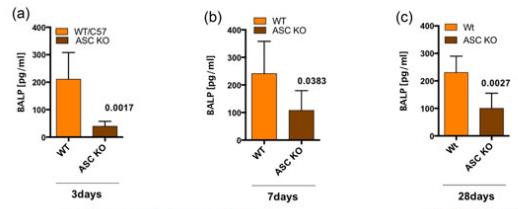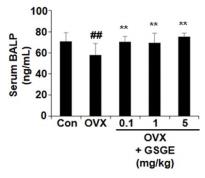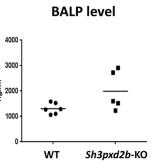-
中文名称:小鼠骨特性碱性磷酸酶(BALP)酶联免疫试剂盒
-
货号:CSB-E11914m
-
规格:96T/48T
-
价格:¥3600/¥2500
-
其他:
产品详情
-
产品描述:
This Mouse BALP ELISA Kit was designed for the quantitative measurement of Mouse BALP protein in serum, plasma, tissue homogenates. It is a Sandwich ELISA kit, its detection range is 1.25 ng/mL-80 ng/mL and the sensitivity is 0.31 ng/mL .
-
别名:Alpl ELISA Kit; Akp-2 ELISA Kit; Akp2 ELISA Kit; Alkaline phosphatase ELISA Kit; tissue-nonspecific isozyme ELISA Kit; AP-TNAP ELISA Kit; TNSALP ELISA Kit; EC 3.1.3.1 ELISA Kit; Alkaline phosphatase 2 ELISA Kit; Alkaline phosphatase liver/bone/kidney isozyme ELISA Kit
-
缩写:BALP
-
Uniprot No.:
-
种属:Mus musculus (Mouse)
-
样本类型:serum, plasma, tissue homogenates
-
检测范围:1.25 ng/mL-80 ng/mL
-
灵敏度:0.31 ng/mL
-
反应时间:1-5h
-
样本体积:50-100ul
-
检测波长:450 nm
-
研究领域:Others
-
测定原理:quantitative
-
测定方法:Sandwich
-
精密度:
Intra-assay Precision (Precision within an assay): CV%<8% Three samples of known concentration were tested twenty times on one plate to assess. Inter-assay Precision (Precision between assays): CV%<10% Three samples of known concentration were tested in twenty assays to assess. -
线性度:
To assess the linearity of the assay, samples were spiked with high concentrations of mouse BALP in various matrices and diluted with the Sample Diluent to produce samples with values within the dynamic range of the assay. Sample Serum(n=4) 1:5 Average % 99 Range % 94-104 1:10 Average % 92 Range % 88-98 1:20 Average % 84 Range % 80-88 1:40 Average % 97 Range % 92-102 -
回收率:
The recovery of mouse BALP spiked to levels throughout the range of the assay in various matrices was evaluated. Samples were diluted prior to assay as directed in the Sample Preparation section. Sample Type Average % Recovery Range Serum (n=5) 95 92-98 EDTA plasma (n=4) 92 87-97 -
标准曲线:
These standard curves are provided for demonstration only. A standard curve should be generated for each set of samples assayed. 
ng/ml OD1 OD2 Average Corrected 80 2.912 2.811 2.862 2.707 40 2.321 2.203 2.262 2.107 20 1.468 1.447 1.458 1.303 10 0.877 0.866 0.872 0.717 5 0.522 0.534 0.528 0.373 2.5 0.350 0.362 0.356 0.201 1.25 0.259 0.267 0.263 0.108 0 0.154 0.155 0.155 -
数据处理:
-
货期:3-5 working days
引用文献
- Ulmus macrocarpa Hance trunk bark extracts inhibit RANKL-induced osteoclast differentiation and prevent ovariectomy-induced osteoporosis in mice C Jeong,Journal of ethnopharmacology,2024
- Icariin promotes bone marrow mesenchymal stem cells osteogenic differentiation via the mTOR/autophagy pathway to improve ketogenic diet-associated osteoporosis HY Yu,Journal of orthopaedic surgery and research,2024
- Bone-targeting engineered small extracellular vesicles carrying anti-miR-6359-CGGGAGC prevent valproic acid-induced bone loss M Ghoneum,Signal transduction and targeted therapy,2024
- Malt1 deficient mice develop osteoporosis independent of osteoclast-intrinsic effects of Malt1 deficiency Monajemi M, et al,Journal of Leukocyte Biology,2019
- Renal involvement in the pathogenesis of mineral and bone disorder in dystrophin-deficient mdx mouse Wada E,The Journal of Physiological Sciences,2019
- Significance of the Tks4 scaffold protein in bone tissue homeostasis Vas V, et al,Scientific Reports,2019
- Rapamycin improves bone mass in high-turnover osteoporosis with iron accumulation through positive effects on osteogenesis and angiogenesis Wu J, et al,Bone,2019
- Apoptosis-associated speck-like protein containing a caspase-1 recruitment domain (ASC) contributes to osteoblast differentiation and osteogenesis Suelen Sartoretto.et al,journal of cellular physiology,2018
- Metformin Alleviates the Bone Loss Induced by Ketogenic Diet: An In Vivo Study in Mice Qi Liu.et al,Calcified Tissue International,2018
- Germinated soy germ with increased soyasaponin Ab improves BMP-2-induced bone formation and protects against in vivo bone loss in osteoporosis Chan-Woong Choi.et al,Scientific Reports,2018
相关产品
问答及客户评论
■ 客户评论
靶点详情
-
功能:Alkaline phosphatase that metabolizes various phosphate compounds and plays a key role in skeletal mineralization and adaptive thermogenesis. Has broad substrate specificity and can hydrolyze a considerable variety of compounds: however, only a few substrates, such as diphosphate (inorganic pyrophosphate; PPi), pyridoxal 5'-phosphate (PLP) and N-phosphocreatine are natural substrates. Plays an essential role in skeletal and dental mineralization via its ability to hydrolyze extracellular diphosphate, a potent mineralization inhibitor, to phosphate: it thereby promotes hydroxyapatite crystal formation and increases inorganic phosphate concentration. Acts in a non-redundant manner with PHOSPHO1 in skeletal mineralization: while PHOSPHO1 mediates the initiation of hydroxyapatite crystallization in the matrix vesicles (MVs), ALPL/TNAP catalyzes the spread of hydroxyapatite crystallization in the extracellular matrix. Also promotes dephosphorylation of osteopontin (SSP1), an inhibitor of hydroxyapatite crystallization in its phosphorylated state; it is however unclear whether ALPL/TNAP mediates SSP1 dephosphorylation via a direct or indirect manner. Catalyzes dephosphorylation of PLP to pyridoxal (PL), the transportable form of vitamin B6, in order to provide a sufficient amount of PLP in the brain, an essential cofactor for enzymes catalyzing the synthesis of diverse neurotransmitters. Additionally, also able to mediate ATP degradation in a stepwise manner to adenosine, thereby regulating the availability of ligands for purinergic receptors. Also capable of dephosphorylating microbial products, such as lipopolysaccharides (LPS) as well as other phosphorylated small-molecules, such as poly-inosine:cytosine (poly I:C). Acts as a key regulator of adaptive thermogenesis as part of the futile creatine cycle: localizes to the mitochondria of thermogenic fat cells and acts by mediating hydrolysis of N-phosphocreatine to initiate a futile cycle of creatine dephosphorylation and phosphorylation. During the futile creatine cycle, creatine and N-phosphocreatine are in a futile cycle, which dissipates the high energy charge of N-phosphocreatine as heat without performing any mechanical or chemical work.
-
基因功能参考文献:
- intestinal alkaline phosphatase knockout mice display higher intestinal Ca uptake, which over time appears to correlate with a positive effect on the biomechanical properties of trabecular bone. PMID: 29234952
- Study results from cerulein induced pancreatitis model in TNAP+/- mice show that altered TNAP expression results in heightened pancreatic inflammation, which may be explained by an augmented response of neutrophils and by a higher sensitivity of acinar cells to cerulein injury. PMID: 30251694
- TNAP activation in vascular smooth muscle cells (VSMCs) appears sufficient to induce calcification. TNAP activation in VSMCs stimulates expression of chondrocyte markers. PMID: 27932058
- Our results offer clear evidence that TNAP modulates T lymphocyte function and specifically T cell-dependent colitis. PMID: 28039309
- The results are the first to demonstrate a role for ENC1 in the control of osteoblast differentiation. Additionally, the contrasting mineralization phenotypes and transcriptional patterns seen with coordinate knockdown of both ENC1 isoforms vs selective knockdown of 67 kDa ENC1 suggest opposing roles for the isoforms in regulation of osteoblastic differentiation, through effects on Alpl expression and phosphate cellular PMID: 27996212
- TNAP overexpression in vascular endothelium in mice leads to an unusual course of coronary atherosclerosis and was accompanied by the reduction in body weight and left ventricular ejection fraction. PMID: 29023576
- Data, including data from studies using cells from transgenic/knockout mice, suggest that Med1 plays role in enamel formation; Med1 induces Alpl via stimulation of Notch1 signaling by forming Notch1-RBP-Jk complex on Alpl promoter. (Med1 = mediator complex subunit 1; Alpl = alkaline phosphatase, liver-bone-kidney; Notch1 = Notch gene homolog 1; RBP-Jk = kappa J region recombining binding protein suppressor of hairless) PMID: 28673966
- These analyses revealed that TNAP deficient mice present an increased proliferation of neural precursors, an altered neuronal morphology, and an augmented neuronal activity. We found that these alterations were associated with a partial downregulation of the purinergic P2X7 receptor (P2X7R). PMID: 27466191
- Despite similar deficiencies in alkaline phosphatase, Alpl(-/-) mice develop craniosynostosis and a brachycephalic/acrocephalic craniofacial shape of variable penetrance. PMID: 26605996
- Prevention of lethal murine hypophosphatasia by neonatal ex vivo gene therapy using lentivirally transduced bone marrow cells expressing Akp-2. PMID: 26467745
- TNAP in the vasculature contributes to the pathology of medial vascular calcification and that it is a druggable target. PMID: 25428889
- In cardiac fibroblasts, TNAP expression and activity is induced by sFRP2. PMID: 25972450
- p107 is required for the efficient recruitment of an activating SWI/SNF chromatin-remodeling complex, an essential event in Alpl induction. PMID: 25182511
- Inhibition of rhBMP-2-induced ALP activity by intracellular delivery of SMURF1 in murine calvarial preosteoblast cells. PMID: 24288199
- Findings demonstrate that Alpl(-/-) mice exhibit a craniofacial skeletal phenotype similar to that seen in infants with HPP, including true bony craniosynostosis in the context of severely diminished bone mineralization PMID: 25014884
- CD73 and TNAP play interactive roles to metabolize luminally applied 5'-AMP in the renal vasculature such that inhibition of both is required to inhibit the production of adenosine. PMID: 24990899
- TNAP plays a role in governing the phosphorylation status of phospholamban in the sarcoplasmic reticulum. PMID: 25015959
- Taken together, these data indicate that ATF3 is a novel negative regulator of osteoblast differentiation by specifically suppressing ALP gene expression in preosteoblasts. PMID: 24315873
- data suggest that the promineralization role of TNAP may be related not only to its accepted pyrophosphatase activity but also to its ability to modify the phosphorylation status of OPN. PMID: 23427088
- mineralization abnormalities of dentin; reduced overall mineralization with decreased matrix vesicle mineralization in the Phospho1(-/-) mice; almost complete absence of matrix vesicles in mice; further reduction in mineralization. PMID: 23694930
- In the cerebral cortex, myelinated axons, while present in wild-type, were absent in the Akp2( -/- ) mice and these animals also displayed a significantly increased proportion of immature cortical synapses. PMID: 22696173
- a link between ATRA-induced mL/B/K-ALP gene transcription and chromatin remodeling PMID: 22270475
- Results demonstrate that TNAP, regulating both ligand availability and protein expression of P2X7 receptor, is essential for axonal development. PMID: 21289095
- Data show that alkaline phosphatase (AP) activity in brain vessels and parenchyma in which AP exhibits specific patterns is attributable to TNAP. PMID: 21191615
- We show that TNAP knockdown reduces cell proliferation and differentiation into neurons or oligodendrocytes PMID: 20849921
- These results demonstrate that calcium ions released from apatite are important in the synergistic effect of 20alpha-HC and apatite. PMID: 20683129
- Once the HT2B receptor is expressed, it constitutively controls tissue-nonspecific alkaline phosphatase activity at a post-translational level along the overall period of bone mineral deposition PMID: 20573958
- Tissue-nonspecific alkaline phosphatase is the enzyme that hydrolyzes both ATP and inorganic pyrophosate in matrix vesicles. PMID: 19874193
- correction of bone mineralization abnormalities in knockout mice null for both the TNAP (Akp2) and PC-1 (Enpp1) genes PMID: 12082181
- The Alpl (Akp2) gene is located within the quantitative trait locus region for alkaline phosphatase activity on chromosome 4. PMID: 16159911
- alkaline phosphatase 2(Hpp/Hpp) mice develop late-onset skeletal disease, notably defective endochondral ossification and bone mineralization that leads to arthropathies of knees and shoulders PMID: 17539739
- The process selectively internalizes IAP and may contribute to the appearance of the enzyme in serum and surfactant-like particles. PMID: 17947448
- Results show that inorganic phosphate (P(i)) levels and TNSALP activity increased in response to androgen/androgen receptor (AR), and P(i) signals increase the expression and translocation of AR. PMID: 18838539
- TNAP-AID mice expressed alpha-fetoprotein and had deleterious mutations in the tumour suppressor gene Trp53, some of which corresponded to those found in human cancer. PMID: 18997814
收起更多
-
亚细胞定位:Cell membrane; Lipid-anchor, GPI-anchor. Extracellular vesicle membrane; Lipid-anchor, GPI-anchor. Mitochondrion membrane; Lipid-anchor, GPI-anchor. Mitochondrion intermembrane space.
-
蛋白家族:Alkaline phosphatase family
-
组织特异性:Widely expressed. Expressed in DRG neurons and spinal cord neurons.
-
数据库链接:
















